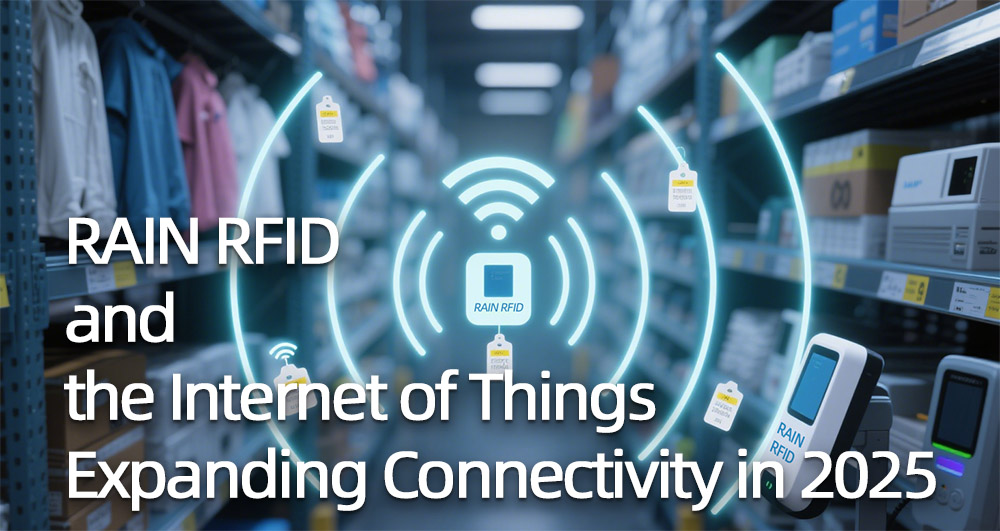Your location: Home Page > RFID Blog | SILION TECH > RAIN RFID and the Internet of Things: Expanding Connectivity in 2025
News and Information
RAIN RFID and the Internet of Things: Expanding Connectivity in 2025
Author:2025-08-07 12:00:00
In 2025, the world is witnessing a significant transformation in how everyday items are connected and managed. This transformation is largely driven by the integration of RAIN RFID (Radio Frequency Identification) and the Internet of Things (IoT). These technologies are not just enhancing the way we interact with objects but are also revolutionizing industries such as retail, logistics, and manufacturing. In this blog, we will explore what RAIN RFID is, its role in the IoT, and how it is expanding connectivity in 2025.

What is RAIN RFID?
Understanding RAIN RFID: RAIN RFID is a wireless technology that connects billions of everyday items to the IoT. It enables consumers and businesses to identify, locate, verify, and engage with each item. RAIN RFID uses radio waves to communicate between tags and readers, making it an ideal solution for bringing low-cost, unique identification to everyday objects.
Global Alliance: RAIN RFID Alliance is supported by a global alliance, similar to other wireless technology organizations like the NFC Forum, Wi-Fi Alliance, and Bluetooth SIG. This alliance ensures that RAIN RFID technology is standardized and interoperable, facilitating its widespread adoption.
The Role of RAIN RFID in the IoT
Connecting Physical and Digital Worlds: The IoT requires a seamless connection between the physical and digital worlds. RAIN RFID bridges this gap by providing a cost-effective and efficient way to tag and track items. This technology is particularly useful in applications where large volumes of items need to be managed, such as in supply chains and inventory management.
Enhancing Business Efficiency: By deploying RAIN Radio Frequency Identification Devices, businesses can significantly improve their operational efficiency. For example, Walmart has reported saving up to $83 billion annually using RAIN RFID, demonstrating the technology's potential to reduce costs and enhance business processes.
Expanding Connectivity in 2025
Market Growth: The RAIN RFID market is experiencing rapid growth. According to recent reports, the global UHF RFID tags shipments reached 540 billion in 2024 and are expected to grow by 13% in 2025. This growth is driven by the increasing demand for better inventory management, improved supply chain visibility, and enhanced customer experiences.
Technological Advancements: To support this growth, RAIN RFID is continuously evolving. The new version of the RAIN RFID air interface protocol, Gen2v3, is set to be released in 2023. This update aims to further improve the speed and accuracy of RAIN RFID deployments, making it even more effective in various applications.
Integration with Other Technologies: RAIN RFID is also being integrated with other IoT technologies to create more robust and versatile solutions. For instance, combining RAIN RFID with Sigfox and NFC can provide a comprehensive connectivity solution for IoT applications.
Applications of RAIN RFID in 2025
Retail and Logistics: RAIN RFID is widely used in retail and logistics to track inventory, manage supply chains, and enhance customer experiences. Retailers can use RAIN RFID to monitor stock levels in real-time, reducing out-of-stock situations and improving sales.
Manufacturing: In manufacturing, RAIN RFID is used for predictive maintenance, energy management, and quality control. By tagging equipment and machinery, manufacturers can monitor their performance, predict failures, and optimize energy usage.
Smart Cities: RAIN RFID is also playing a crucial role in the development of smart cities. It is used in various applications, such as traffic management, waste management, and public safety. For example, RAIN RFID can be used to optimize traffic signals, reducing congestion and improving traffic flow.
RAIN RFID and the IoT are transforming the way we interact with everyday items and manage our businesses. By providing a cost-effective and efficient way to connect and track items, UHF RFID Modules are expanding connectivity and driving innovation across various industries. As the technology continues to evolve, we can expect even more exciting applications and benefits in the future.
Additionally, SILION TECH has officially joined the RAIN Alliance and become an important member of the organization.